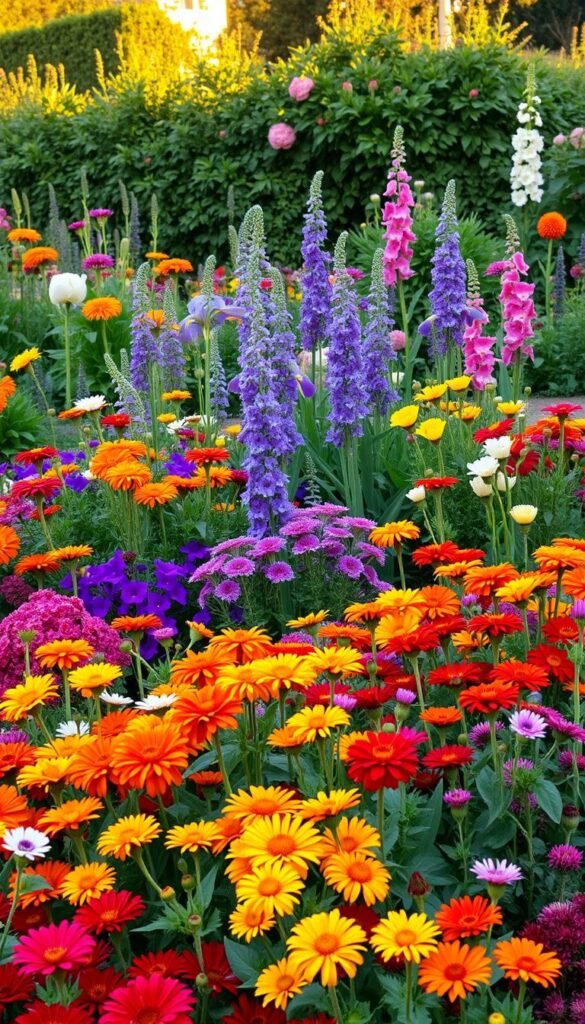Transforming your outdoor space into a vibrant retreat requires smart plant partnerships. Seasonal bloomers bring instant energy with their bold colors, while reliable perennials establish your garden’s foundation. Together, they create displays that evolve beautifully from spring through fall.
Fast-growing varieties like petunias or marigolds fill empty spots between established plants, ensuring no bare patches. Meanwhile, drought-resistant options like lavender offer both visual appeal and eco-friendly benefits. This approach keeps your beds lively even when some plants finish blooming.
By mixing short-term showstoppers with enduring favorites, you’ll maximize your landscape’s potential. The result? A dynamic space that delights the senses and supports local pollinators. For spaces beyond traditional beds, our patio container gardening guide offers clever solutions using similar principles.
You’ll discover how contrasting textures and bloom times create visual depth. With thoughtful planning, your landscape becomes a living masterpiece that changes gracefully with each season.
Crafting Your Vision for a Stunning Backyard Garden
Your ideal outdoor oasis takes shape when you blend creativity with practical planning. Start by sketching rough ideas or collecting inspiration photos—this helps translate dreams into actionable steps. Successful designs balance beauty with functionality, ensuring every plant serves a purpose while delighting the senses.
Setting Goals for Color, Texture, and Scale
Choose a color scheme that makes your heart sing. Vibrant reds and yellows create energy, while cool blues and purples offer calm. Mix foliage textures like feathery ferns with bold hosta leaves for tactile contrast. Remember: tall sunflowers need breathing room, while compact begonias thrive in cozy corners.
Consider sunlight patterns and soil quality before selecting plants. Native species often require less maintenance—explore perennial garden ideas for low-effort beauty. As one landscape designer notes: “A garden that fights its environment never truly flourishes.”
Identifying Your Garden’s Unique Personality
Do clipped hedges and symmetrical beds spark joy? Or do wildflower clusters and meandering paths feel more authentic? Your space should reflect your lifestyle—formal layouts suit entertainers, while cottage-style plantings attract nature lovers.
Play with elevation changes using raised beds or trailing vines. For small areas, try colorful container displays that add vertical layers. By harmonizing structure with spontaneity, you’ll create a living canvas that evolves beautifully through seasons.
Choosing the Perfect Annuals and Perennials
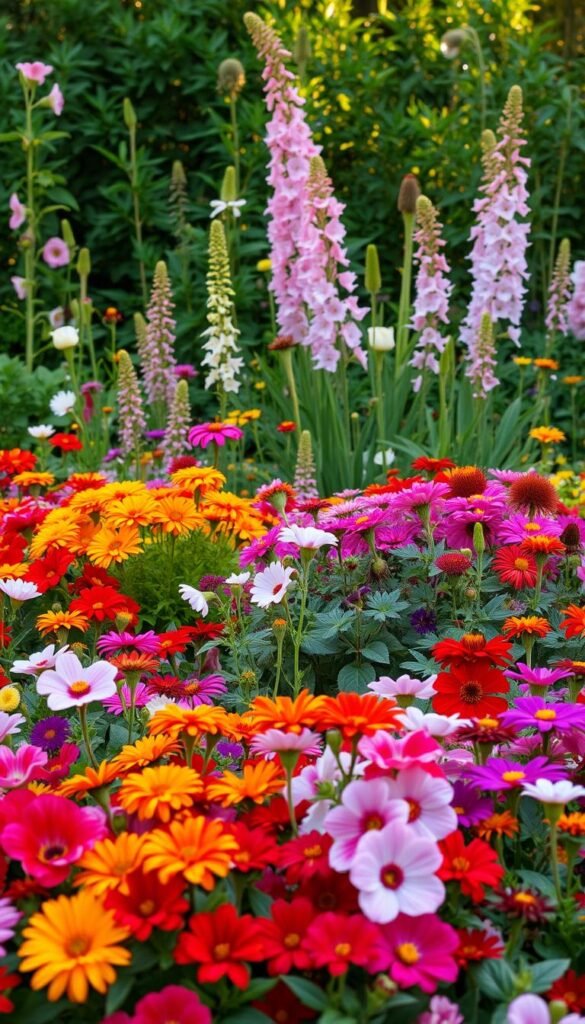
Creating a garden that thrives year after year starts with smart plant choices. Annuals bring bold seasonal color, while perennials offer enduring structure. Together, they form a dynamic partnership that keeps your space lively through changing weather.
Key Characteristics of Annuals
Annuals deliver instant impact with their fast growth and nonstop blooms. Zinnias burst open in fiery shades, their wide petals welcoming butterflies and bees. Petunias cascade over containers, showering your space with color from spring’s first warmth until autumn’s chill.
Marigolds pull double duty – their golden flowers brighten beds while naturally deterring pests. For quick results, try low-maintenance varieties in raised beds where they’ll flourish with minimal effort.
Benefits of Perennial Plants
While annuals dazzle temporarily, perennials build your garden’s foundation. These steadfast plants return each season, growing stronger roots and broader spreads. Think of them as your landscape’s backbone – daylilies’ strappy leaves frame summer blooms, while sedum’s fleshy foliage adds winter texture.
Seasoned gardeners often mix both types. “Annuals fill gaps while perennials establish,” notes horticulturist Linda Chalker-Scott. This approach creates layered interest – fleeting beauty meets lasting form in every bed and border.
Pairing Annuals and Perennials for a Long-Lasting Backyard Flower Garden Display
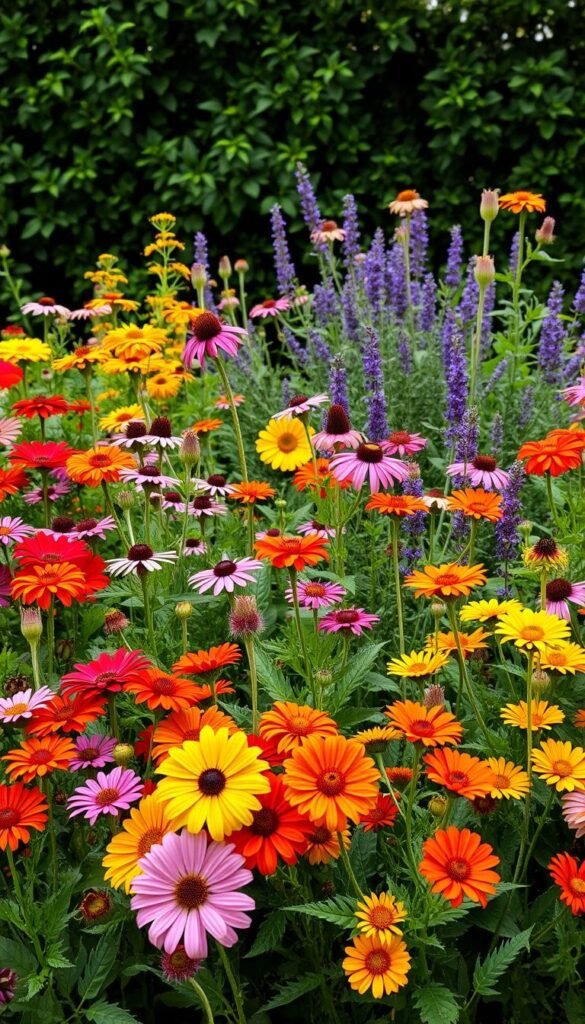
Dynamic gardens thrive on the interplay between fleeting and enduring blooms. Strategic pairings transform ordinary spaces into living tapestries that shift with the seasons while maintaining year-round appeal.
How to Create Harmony with Complementary Combinations
Contrast becomes your greatest ally when mixing short-lived color bursts with reliable performers. Try purple salvia spikes behind golden marigolds – their opposing hues intensify each other while their shared sun-loving nature simplifies care.
Ornamental grasses like fountain grass add fluid motion to your flower bed. Their wispy plumes dance alongside zinnias’ bold petals, creating depth through texture variation. For borders, snow-white alyssum forms a frothy carpet that highlights taller plants without competing for attention.
Expert gardener Melissa King suggests: “Match growth habits first, then play with visual opposites.” This approach ensures companions share water and light needs while delivering striking differences in form or color.
Layer bloom times to maintain continuous interest. Early-flowering tulips pair beautifully with late-summer black-eyed Susans, their overlapping seasons creating seamless transitions. Remember: successful combinations balance instant gratification with future rewards.
Enhancing Color, Contrast, and Visual Impact
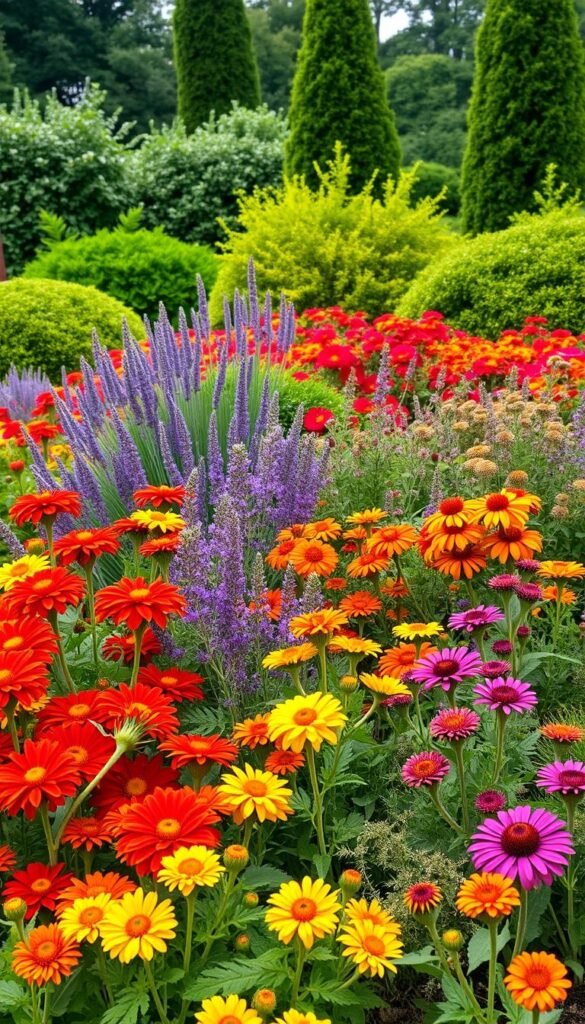
Your garden’s color palette acts as its heartbeat, pulsing with energy or soothing with calm. Sunlight intensity dramatically alters how hues appear – bold reds and yellows pop under midday rays, while soft pinks might vanish in the glare. Smart selections create rhythm that guides the eye and stirs emotions.
Utilizing Bold and Subtle Color Choices
Primary colors become superheroes in sunny spaces. Marigolds’ golden blooms and geraniums’ fiery reds stay vivid even during summer’s peak. Pair them with cobalt blue salvias for a triadic scheme that commands attention. Pastel lovers aren’t left out – use these delicate shades in shaded areas where their subtlety shines.
Struggling with combinations? Try purple and chartreuse. Lavender spikes behind golden sweet potato vines create instant drama in containers or borders. This duo works because opposites attract – warm and cool tones balance each other perfectly.
Plan your garden like a seasonal wardrobe. Start with spring’s pale tulips, transition to summer’s zinnia rainbows, then finish with autumn’s rusty mums. Multi-colored flowers like calibrachoas offer built-in harmony, simplifying design choices while adding depth.
Remember: your home’s exterior sets the stage. Match terracotta walls with warm oranges, or cool gray siding with violet asters. As landscape designer Emma Carter advises, “Colors should converse, not clash, with their surroundings.”
Creating a Layered and Textured Planting Design
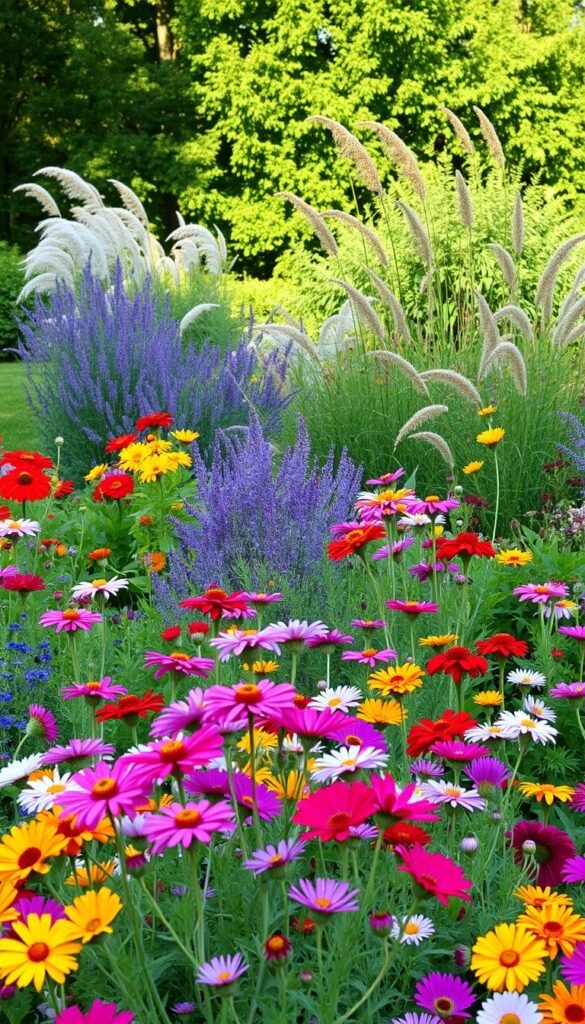
Great gardens work like nature’s theater—each plant plays its part at the right height. Start by visualizing your space as three acts: backstage performers, supporting actors, and front-row stars. This approach ensures every leaf and petal gets its moment in the spotlight.
Arranging Plants by Height and Foliage Shape
Tall plants form your garden’s backbone. Hollyhocks or delphiniums create vertical drama at the rear. Mid-height bloomers like geraniums fill the middle ground, while creeping thyme or sedum carpet the foreground. Contrast spiky ornamental grasses with rounded hosta leaves for tactile intrigue.
Try this simple formula: place feathery cosmos behind broad-leafed coleus, with woolly thyme hugging the soil. The result? A living collage that draws the eye through multiple layers. Remember to check mature sizes—overcrowded plants lose their definition.
Achieving Depth with Groundcovers and Border Plants
Low-growing varieties do heavy lifting in your flower bed. Sweet woodruff suppresses weeds while softening edges, and blue star creeper adds unexpected color between stepping stones. For borders, mix evergreen lavender with annual alyssum—their contrasting heights create natural framing.
| Position | Plant Examples | Texture Type |
|---|---|---|
| Back | Sunflowers, Foxglove | Bold vertical |
| Middle | Salvia, Coral Bells | Medium density |
| Front | Sedum, Thyme | Fine carpet |
Border plants like dwarf boxwood keep your design crisp. They guide visitors’ gaze while hiding fading foliage. Pro tip: Use variegated ivy along pathways—its marbled leaves add motion without overwhelming nearby blooms.
Incorporating White Flowers for a Timeless Accent
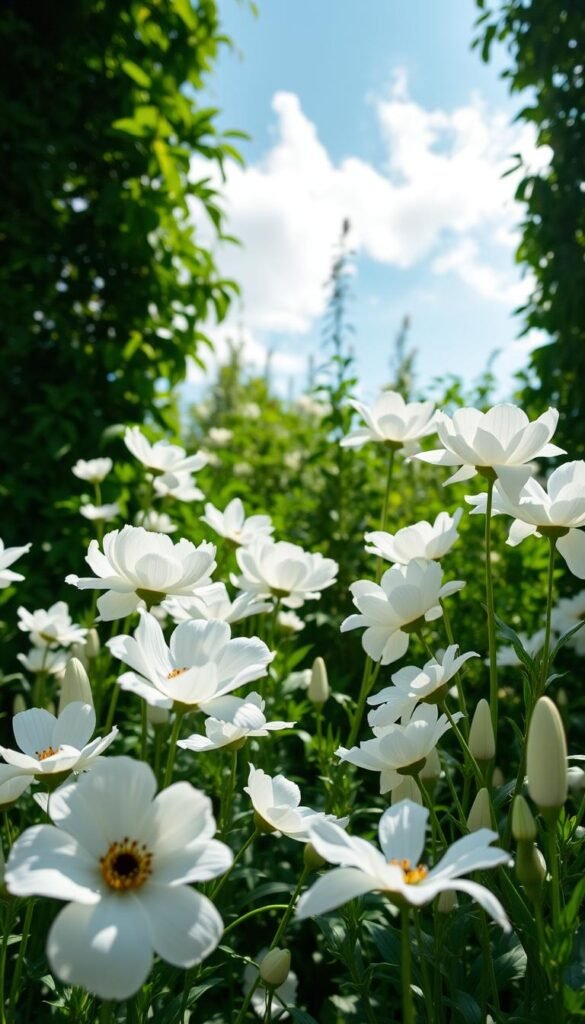
White blossoms act as nature’s neutral, bringing clarity to chaotic color schemes. These luminous blooms create breathing room between vibrant hues while adding moonlight magic to evening landscapes. Their versatility makes them essential for balancing bold designs and softening structural elements.
Emphasizing Purity and Balance in Your Garden
White flowers serve as visual connectors, blending disparate colors into cohesive displays. Plant snowy petunias between hot pink geraniums to cool their intensity. In shady corners, white impatiens brighten dark foliage like living spotlights.
Mix annuals like cosmos with perennials such as shasta daisies for nonstop ivory tones. Moonflowers open their fragrant trumpets at dusk, creating ethereal night displays. As master gardener Elena Carter observes: “White isn’t just a color—it’s a design tool that harmonizes your entire space.”
Vary textures for depth—pair delicate baby’s breath with bold hydrangea clusters. Silver-leafed artemisia or variegated hostas amplify white’s crispness without competing. For modern flair, alternate black-eyed Susans with snow-white zinnias in geometric patterns.
These blooms excel in small spaces too. A single white rose bush elevates patio containers, while trailing sweet alyssum softens stone pathways. Wherever you plant them, white flowers deliver sophistication that never fades with fashion.
Attracting Pollinators and Ensuring Seasonal Blooms
Turn your garden into a buzzing sanctuary by welcoming nature’s hardest workers. A well-planned space teems with life when you prioritize plants that nourish winged visitors through every season.
Strategies to Bring in Bees, Butterflies, and Hummingbirds
Nectar-rich flowers act as pollinator magnets. Salvias’ tubular blooms draw hummingbirds like living straws, while zinnias’ flat petals give butterflies perfect landing pads. Include spider flowers for their long-lasting summer color and frequent bee visits.
Group similar plants together to create target-rich feeding zones. Morning sun areas work best for attracting early risers like honeybees. For evening interest, plant night-scented nicotiana that lures moths under moonlight.
Coordinating Bloom Times from Spring to Fall
Start with crocuses and lungwort for early spring nectar. Transition to summer stars like bee balm and coneflowers. Autumn’s goldenrod keeps feeders busy until frost. Stagger planting dates for continuous flowering—this simple trick maintains food sources when pollinators need it most.
New to gardening? Try beginner-friendly blooms like marigolds and cosmos. These low-effort options deliver high-impact results for both aesthetics and ecology. As one gardener puts it: “When you feed pollinators, your whole garden thrives.”

